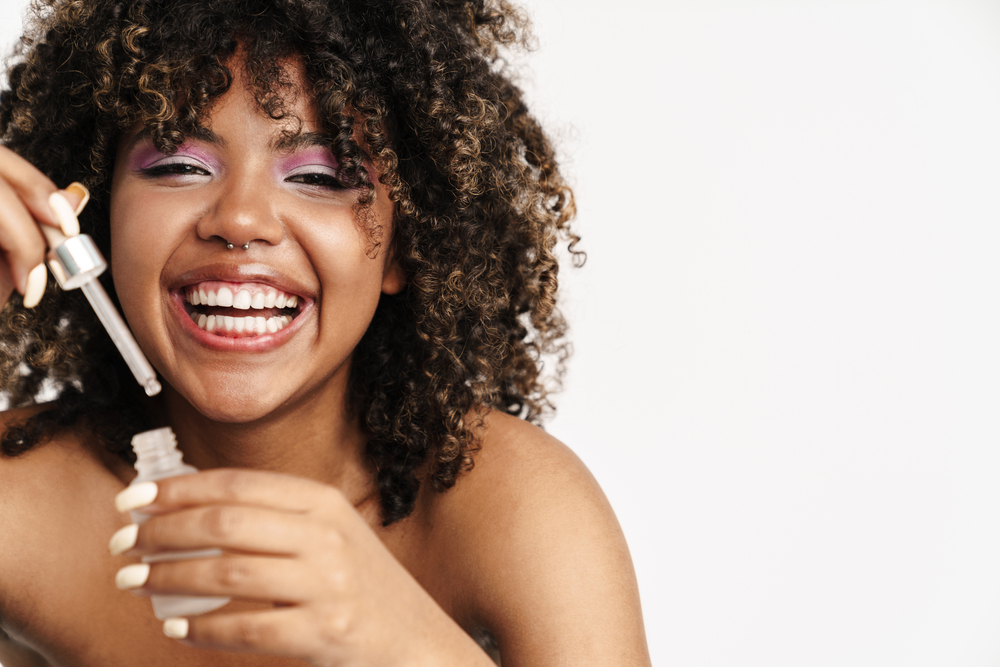

We all want healthy, vibrant hair; several essential oils can be game-changers in our textured hair care routines. Specific oils that are best for textured hair nourish our locks, promote growth, and improve scalp health. From rosemary oil that strengthens hair to coconut oil that moisturizes, these natural ingredients offer a wealth of benefits for textured hair.
This article explores the top essential oils for hair growth and how to use them effectively. Powerful combinations like lavender and rosemary work wonders for hair health. Tea tree and peppermint oils invigorate the scalp. Finally, cedarwood and clary sage can balance and strengthen our textured hair.
Table of Contents
Lavender and Rosemary: A Powerful Duo for Textured Hair Health
Combining lavender and rosemary essential oils creates a powerful duo for promoting hair health. These two oils complement each other beautifully, offering a range of benefits for our locks and scalp.

Synergistic Effects of Combining Lavender and Rosemary Oils
When used together, lavender and rosemary oils have a synergistic effect that enhances their individual properties. Lavender oil is renowned for its soothing properties, which can help reduce stress-related hair problems people with textured hair often deal with. It also has antimicrobial properties that keep the scalp healthy. On the other hand, Rosemary oil is known for its ability to increase circulation, which is crucial for hair growth.
The combination of these oils provides a dual action: rosemary stimulates blood flow to the hair follicles, while lavender conditions and calms the scalp. This powerful blend has been shown to significantly increase the number of hair follicles and deepen follicle depth, especially when combined with a carrier oil like jojoba [1] . These impressive benefits of using rosemary and lavender oils are why Jaycee Naturals developed an oil containing them both.
Creating a Lavender-Rosemary Scalp Massage Oil
To harness the benefits of these essential oils, consider creating a simple yet effective scalp massage oil. Here's how you can make your own:
Start with a carrier oil base, such as jojoba or coconut oil. These oils help dilute the essential oils and nourish the hair and scalp.
For every ounce of carrier oil, add about 5 drops each of lavender and rosemary essential oils [2] .
Mix the oils thoroughly in a dark glass bottle to protect them from light.
To use this blend, part your hair and apply 2-3 drops directly to the scalp, gently massaging it in. This massage helps distribute the oils and stimulates blood flow to the scalp, enhancing the oils' effects. You can use this lavender-rosemary blend daily [3] . However, if you have a sensitive scalp, you might want to start with once or twice a week and gradually increase as your scalp adjusts.
Things to consider:
- It's important to note that while these oils have shown promise in promoting hair growth and health, results can vary from person to person. Hair loss and thinning can have multiple causes, including age, hormones, genetics, stress, and certain medications. While essential oils can be a helpful addition to your hair care routine, they're not a guaranteed solution for all hair issues.
- Consistency is key when using essential oils for hair care. It may take several weeks or even months to see noticeable results. During this time, it's crucial to maintain a healthy diet, manage stress levels, and follow a good hair care routine to support the effects of the essential oils.
- Remember, everyone's hair is unique, so what works for one person might not work the same way for another. It's always a good idea to do a patch test before applying any new product to your scalp and consult a healthcare professional if you have any concerns about hair loss or scalp conditions.
By incorporating this lavender and rosemary oil blend into your hair care routine, you're naturally nourishing your scalp and promoting healthy hair growth. The calming scent of lavender combined with the invigorating aroma of rosemary makes this blend not just beneficial for your hair, but also a delightful sensory experience.
Tea Tree and Peppermint: Invigorating Scalp Care Combination
Tea tree and peppermint oils make an excellent combination for invigorating scalp care. This dynamic duo offers a range of benefits that can help improve hair health and promote growth.

Benefits of Tea Tree and Peppermint Oil for Scalp Health
Tea tree oil is renowned for its antimicrobial and antifungal properties, making it a natural choice for maintaining a clean and healthy scalp. It helps reduce flaking while moisturizing the scalp, which is especially beneficial for those dealing with dandruff or other scalp issues.
Peppermint oil, on the other hand, stimulates the scalp. It increases blood flow to the hair follicles, promoting hair growth and creating a healthier environment for your textured hair. The refreshing tingle you feel when applying peppermint oil indicates that it's working its magic.
When combined, these oils create a potent formula that cleanses the scalp, combats dandruff, and promotes a healthier scalp environment. This combination has been shown to significantly impact hair health, potentially increasing the number of hair follicles and deepening follicle depth.
Creating a Tea Tree and Peppermint Scalp Toner
Creating your own tea tree and peppermint scalp toner is a simple way to incorporate these beneficial oils into your textured hair care routine. Consider this simple recipe:
Ingredients:
2 ounces of boiled, filtered water
3 drops of tea tree oil
2 to 3 drops of peppermint essential oil
1 drop of eucalyptus essential oil (optional)
1 drop of rosemary essential oil (optional)
Instructions:
Allow the boiled water to cool to room temperature.
Combine the water and essential oils in a dark glass bottle to protect them from light.
Shake well to mix the ingredients.
To use this toner, part your hair and spray the toner directly onto your scalp. Gently massage it in to stimulate blood flow and ensure even distribution. You can use this toner daily or a few times a week, depending on your hair's needs.
Precautions when using this potent oil blend:
While tea tree and peppermint oils offer numerous benefits, it's important to use them safely. Here are some precautions to keep in mind:
- Always dilute essential oils before applying them to your scalp. Using them undiluted can cause irritation or burning sensations.
- Perform a patch test before using the toner on your entire scalp. Apply a small amount to the inside of your wrist and wait 24 hours to check for any adverse reactions.
- If you have sensitive skin or a history of allergies, consult with a healthcare professional before using essential oils.
- Avoid getting the oil blend in your eyes. If this happens, rinse thoroughly with water.
- Some essential oils can increase skin sensitivity, especially to sunlight. Be cautious when exposing your scalp to direct sunlight after applying the toner.
- If you're pregnant or breastfeeding, consult with your doctor before using essential oils in your hair care routine.
Remember, everyone's hair and scalp are different. What works for one person might not work for another. It's always best to start with a small amount and gradually increase as your scalp adjusts. Consistent use of this tea tree and peppermint can help invigorate your scalp, potentially leading to healthier, stronger hair.
Cedarwood and Clary Sage: Balancing and Strengthening Hair
Cedarwood and clary sage essential oils are another powerful combination for textured hair care. These oils complement each other beautifully and offer a range of benefits for the locks and scalp - including the ability to balance and strengthen the hair.

How Cedarwood and Clary Sage Complement Each Other
Cedarwood essential oil is known for stimulating hair follicles by increasing blood flow to the scalp. This property helps reduce thinning hair problems and various types of alopecia. It's also an efficient tonic for overall hair health, with an excellent reputation for preventing hair loss and promoting new hair growth.
Clary sage, on the other hand, has some similar properties to rosemary and cedarwood oils due to its ability to increase cellular metabolism and balance scalp oils. It provides hormone-balancing qualities and works well for promoting hair growth. Clary sage is also known for eliminating dandruff and limiting oil buildup that can clog hair follicles by reducing sebum production.
When used together, cedarwood and clary sage create a synergistic effect. Cedarwood's ability to stimulate blood flow complements clary sage's hormone-balancing properties, resulting in a powerful blend that can address multiple hair concerns simultaneously.
Making a Cedarwood-Clary Sage Hair Serum
Creating your own cedarwood and clary sage hair serum is a simple way to incorporate these beneficial oils into your hair care routine. Try this low-hassle recipe:
Ingredients:
3 ounces of carrier oil (such as a mixture of jojoba and grapeseed oil)
30 drops of cedarwood essential oil
30 drops of clary sage essential oil
Instructions:
Combine the carrier and essential oils in a dark glass bottle to protect them from light.
Shake well to mix the ingredients thoroughly.
To use this serum, part your hair and apply a small amount directly to your scalp, gently massaging it in. This massage helps distribute the oils and stimulates blood flow to the scalp, enhancing the oils' effects.
For best results, consider leaving the serum on overnight and wash it out in the morning.
Top hair concerns for this essential oil combination:
The cedarwood and clary sage combination is particularly effective for certain hair concerns:
- Thinning hair: The stimulating properties of cedarwood can help promote hair growth and reduce hair loss.
- Dry or damaged hair: Both oils have moisturizing properties that help repair and strengthen hair.
- Dandruff-prone hair: The antifungal properties of cedarwood can help combat dandruff and other scalp conditions.
By incorporating this cedarwood and clary sage blend into your textured hair care regimen, you're taking a holistic approach to nourishing your scalp and promoting healthy hair growth. The woodsy scent of cedarwood combined with the herbaceous aroma of clary sage benefits your hair and provides a delightful sensory experience.
Conclusion
Exploring essential oils for textured hair care opens up a world of possibilities to enhance hair health and promote growth. By understanding the unique properties of oils like lavender, rosemary, tea tree, peppermint, cedarwood, and clary sage, you can create custom blends that address your specific hair concerns. These natural remedies have the potential to revolutionize your textured hair care routine, offering a holistic approach to achieving stronger, healthier, and more vibrant hair.
Remember, consistency is key when incorporating essential oils into your hair care regimen. It may take time to see noticeable results, so patience is crucial. As you experiment with different oil combinations, pay attention to how your hair and scalp respond and adjust your routine accordingly. With the right blend of essential oils and a commitment to textured hair care, you're on your way to unlocking the full potential of your locks and embracing the beauty of healthy, textured hair.
Checklist of Essential Oils for Your Textured Hair
Lavender and rosemary to soothe scalp and circulate blood
Tee tree and peppermint to clean scalp and increase blood flow
Cedarwood and clary sage to stimulate hair follicles and balance scalp oils
References
[1] - https://www.brambleberry.com/shop-by-craft/hair-care/essential-oils?srsltid=AfmBOopVY7mdK8NT5WWo8FPzLDByR55DzjEBXaxr1xgVp7hf4HwulfqW
[2] - https://www.eoproducts.com/collections/hair
[3] - https://www.verywellhealth.com/the-best-hair-oils-for-every-hair-type-4154056




